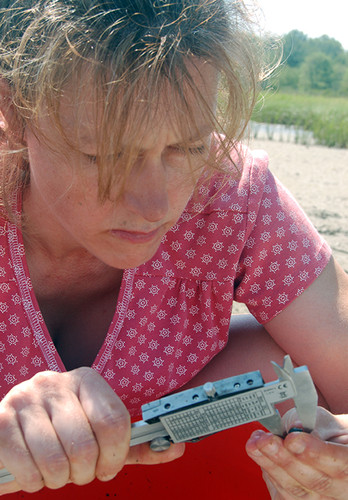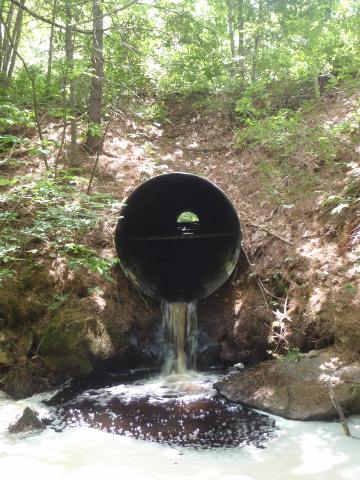The Wrack
The Wrack is the Wells Reserve blog, our collective logbook on the web.
The Wrack is the Wells Reserve blog, our collective logbook on the web.
Hi Everyone,
Thought I would share some numbers from our System Wide Monitoring Program (SWMP) weather station here at the Reserve, and compare them to some values from around the area. First off, it seems we got "lucky" with rain fall totals. Both the Reserve station and the Portland International Jetport weather station reported just over an inch of rain on Tuesday. However rainfall totals varied a bit depending on where those "bands" of precipitation hit… pretty minor event as far as actual rainfall goes, but when that rain is being blown sideways at close to 60mph. Speaking of wind…
It’s that time of year… fall is in the air and (if you’re a brook trout) love is in the air too! October and November is prime spawning time for Eastern Brook Trout. They’ve been fattening up all summer on aquatic insects. Now the mature females have bellies full of eggs and are looking for a spots with cold, clear water and loose, clean gravel where they can make their nests, called redds.
WELLS, Maine, October 1, 2012 — The Wells National Estuarine Research Reserve and Laudholm Trust have honored the late Dr. Michele Dionne, the reserve’s lead scientist and long-time research director, by placing her name on the research laboratory of the Maine Coastal Ecology Center at the Wells Reserve at Laudholm. The announcement was made by Laudholm Trustee Cynthia Daley and Reserve Director Paul Dest at a memorial service held at the reserve on September 23.
 Jennifer Dijkstra was always going to be a scientist. As a child summering on Grand Manan, she clambered over the island’s rocky shoreline grabbing fistfuls of seaweed and peering into shallow waters to spy on crabs and snails. This summer she’s been doing the same thing, but with three degrees of separation (BS, MS, and PhD), she now calls her objects of interest Ascophyllum, Carcinus, and Littorina.
Jennifer Dijkstra was always going to be a scientist. As a child summering on Grand Manan, she clambered over the island’s rocky shoreline grabbing fistfuls of seaweed and peering into shallow waters to spy on crabs and snails. This summer she’s been doing the same thing, but with three degrees of separation (BS, MS, and PhD), she now calls her objects of interest Ascophyllum, Carcinus, and Littorina.
For many budding biologists, the journey from tide pool playground to salt marsh research transect stops short. For Dr. Dijkstra, research scientist at the Wells Reserve, the dream came true.
Since her arrival at the Wells Reserve at Laudholm in 2008, research scientist Dr. Jennifer Dijkstra has followed two main lines of inquiry. In addition to investigating seaweed, crab, and snail interactions in the salt marsh, she has also looked into how climate change may affect mercury accumulation in coastal food webs.
When Jenn started her post-doctoral fellowship, research director Michele Dionne asked her to work on mercury. "It was a little daunting," Jenn admits. "I had never worked on contaminants, and mercury is not a straightforward contaminant."
Back in July, Wells Reserve staff and interns teamed up with volunteers from the Sebago Chapter of Trout Unlimited and bravely struck out on an ambitious survey of road-stream crossings in the Kennebunk River, Merriland River, and Branch Brook. The teams worked hard and surveyed an amazing 81 road-stream crossings in only three days!
 I led one of the survey teams and let me tell you, that data was hard-earned! Once we had located a crossing, we had to battle thick brush, mud, poison ivy and steep slopes of riprap to reach the stream. To measure the length of a crossing, we sometimes had to crawl through a culvert from one end to the other, dodging spider webs along the way. Besides being a fun excuse to go crashing through woods and splashing through rivers, this survey was an important way to gather data that will be used by town planners, landowners, conservation groups, and other stakeholders to reconnect stream habitat in these watersheds.
I led one of the survey teams and let me tell you, that data was hard-earned! Once we had located a crossing, we had to battle thick brush, mud, poison ivy and steep slopes of riprap to reach the stream. To measure the length of a crossing, we sometimes had to crawl through a culvert from one end to the other, dodging spider webs along the way. Besides being a fun excuse to go crashing through woods and splashing through rivers, this survey was an important way to gather data that will be used by town planners, landowners, conservation groups, and other stakeholders to reconnect stream habitat in these watersheds.
I want to share some pictures that highlight some nice days for research throughout the local area, including the Saco River, the Merriland River, Branch Brook, the Little River Salt Marsh, and Big Daddy's Ice Cream.
Fellow Research Intern Tim Dubay and I have been working with Jeremy Miller this summer to expand the Wells Reserve’s ongoing larval fish project. We're "Team Larval Fish!"
The Shoreys Brook dam came out in November 2011, and since then the brook has been steadily carving its way through the sediment that has collected for over a century in the impoundment. Vegetation is starting to take hold in places, but it will be a few years before it begins to look like anything but a large mud pit. As old sediment flushes away, older substrates begin to emerge along the stream bottom, showing signs of what the brook once looked like. Gravel, cobble stones, and even boulders can now be seen littering the stream, which is a positive sign for the restoration team. Rainbow smelt are looking for just this type of stream bottom to lay their eggs on in the early spring.
We saw a cold and wet start to the month of June here in Southern Maine. I thought I would share some SWMP data from a few of our stations to illustrate how weather can significantly impact the water quality of our estuaries